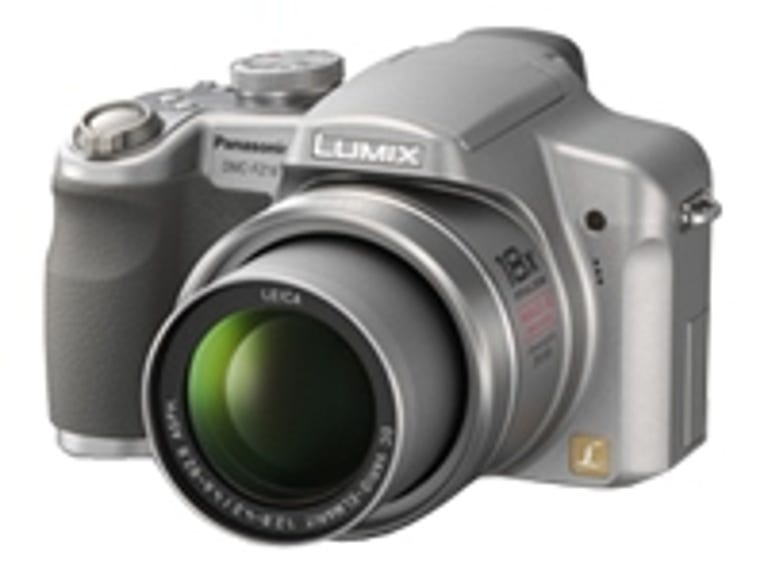 Why You Can Trust CNET
Why You Can Trust CNET Panasonic Lumix DMC-FZ18 review: Panasonic Lumix DMC-FZ18
Panasonic Lumix DMC-FZ18
Though far from perfect, the Panasonic Lumix DMC-FZ18 shapes up to be the best of the cameras promising 18x-zoom Nirvana we've reviewed so far, a trio rounded out by the slow Fujifilm FinePix S8000fd and the slower Olympus SP-550 UZ. Like those models, the FZ18 incorporates a wide aperture, wide-angle lens, specifically f/2.8-to-f/4.2 28mm-to-504mm, and like the S8000fd, incorporates an 8-megapixel sensor.
The Good
The Bad
The Bottom Line
Its design looks quite similar to its 7-megapixel, 12x-zoom line mate, the
Panasonic doesn't skimp on shooting options here. In addition to a full set of manual, semi-manual, automatic, and scene program exposure modes, and the standard three metering choices--spot, center and multiple--the FZ18 includes six autofocus algorithm options: Face, 1-point, 1-point high speed, 3-point high speed, Multi-point, and Spot. It also offers automatic scene detection, rather sluggish face-detection, and Intelligent Auto mode, which enables the image stabilizer, uses Intelligent ISO (automatic up to the user set cap), face detection, automatic scene mode detection, and continuous AF. The three-shot self-timer provides a retro photo-booth experience. And not only does the FZ18 offer raw mode, it also supplies a raw-plus-JPEG option, which we generally see only in midrange and higher dSLRs.
Choosing a rating for the FZ18's image quality was unusually difficult. At its best, the FZ18 snaps excellent photos: sharp, with accurate exposure, good color rendering, reasonable lens geometry, and only modest noise at the low-to-middle ISO sensitivities. However, this seems to apply predominantly under natural lighting. CNET Labs tests indoors under tungsten and fluorescent lights not only exhibited poor automatic white balance, but above average noise and compression artifacts in the JPEG images. The raw versions of the photos (opened with Adobe Camera Raw using the default settings for the file format), with their adjusted white balance, less sharpening and slightly more noise suppression, came out far better than the JPEGs. True, they're a bit softer, but the trade-off seems to be more than worth it. Unfortunately, since I foresee most users shooting JPEG--it's faster than raw in the FZ18--I docked the FZ18's image-quality rating a point. You can see what I mean if you look at the image samples.
The FZ18 performs typically for its class. From power on to first shot takes only 1.8 seconds, pretty quick for a long-lenser. Time to focus and shoot runs only 0.7 second in good light, rising to 1.1 seconds in dimmer situations--good for a non-dSLR, but still slower than you want. The interval for two consecutive shots is a brisk 1.3 seconds, which rises to an uncommonly fast 1.8 seconds with flash. Raw capture runs a bit slower--2.3 seconds for two sequential shots--which makes raw shooting a suboptimal workaround for the JPEG issues discussed earlier. In burst mode, it snaps at a clip of about 3.7 frames per second, but the camera's continuous shooting is limited to 7 frames at standard quality and 4 frames at fine quality.
Panasonic's Mega OIS image stabilizer works well, as always. In casual testing, photographing a stationary subject indoors at the camera's maximum 504mm-equivalent focal length using multipoint focus, I was able to shoot a reasonably sharp photo at 4 stops slower than mandated by the reciprocal focal-length rule; 1/125 second instead of 1/2,000 second. On the other hand, the FZ18's relatively low resolution 207,000-pixel 2.5-inch LCD and EVF disappoint. Typical for this class of cameras, they preview completely different color and exposures, but worse, they update far slower those of than competitors such as the S8000fd, making it difficult to shoot active subjects such as kids and pets.
You don't have much choice if you want one of these really long-lensed megazooms, but the Panasonic Lumix DMC-FZ18 looks to be the best of a not-so-great lot. It's a fine camera, as long as you keep in mind its shortcomings and can work around them.
(Smaller bars indicate better performance )
(Longer bars indicate better performance)



